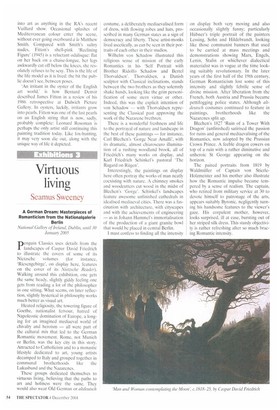Last pearl
Laura Gascoigne
James Fitton RA: A Very English Painter
Crane Kalman Gallery, until 15 January In the official account of British 20th century art, the big names belong to the international players whose universal vision won them a place in the annals of world art. This is understandable. What is harder to explain is the official version's almost total neglect of those native artists who kept alive, through this century of global change, the peculiarly English tradition founded by Hogarth. Carel Weight, Ruskin Spear, Richard Eurich — names virtually unknown to the general public — all played a part in this unwritten history, as did the David Hockney of A Rake's Progress before defecting to America. Another key figure was James Fitton (1899-1982), whose reputation is up for reassessment in a show of paintings at Crane Kalman.
Fitton had a difficult background for an artist. The son of an Oldham machineworker and union activist, he entered employment at the age of 14 and had to acquire all his art education at evening classes, first at Manchester School of Art — where he made friends with the much older Lowly — and later at the Central School in London. From his father, he inherited socialism — he was a founder member of the Artists' International Association and a political cartoonist for Left Review — and a Northern work ethic that kept him in commercial employment all his life, as an illustrator for magazines and as art director and adviser to the ad agency Vernon's.
By today's rules — since Bohemia became Sohemia — this would scupper anyone's hopes of painting, but paint Fitton did, showing regularly at the Academy and missing the Presidency by a whisker on three occasions — the first, in 1956, prompting Munnings to fume in the Daily Mail: 'I heard that creature Fitton might be elected. I've had letters from members appalled at the prospect
. Fitton can't paint and he can't draw.'
As this show proves, he could do both, and he put his considerable abilities at the service of an English illustrator's unerring eye for social circumstance. All of English life is here. There's the red-faced gent hunched over his paper in a 'Cafe Scene' (1948), whose faded grandeur is bathed in an afterglow of tannin, HP Sauce and nicotine, to which his cigarette is making its contribution. There's the drunken fumble in the poster-papered alley in 'The Proposition' (c.1965) about to degenerate into a knee-trembler — even the alley cat is slinking off in disgust — and the more discreet encounter in 'Conversation Piece' (c.1950) between a hurriedly disrobing couple whose bodies, oriented at 90 degrees, tell us, with a lightness Sickert might envy, that the transaction is a commercial one. There's the bracingness of British beach life under canvas in 'The Beach Tent, Swanage' (c.1933), and the sheer misery of the evening 'Promenade' (c.1936), where the sea air is being taken like medicine by an old chap in an oilskin being wheeled along in a bath chair by his frail little wife.
It's the female sex for which Fitton reserves his sharpest eye, from the bonyshouldered, slack-jawed society woman squinting into her compact as she applies shocking-pink lipstick, to the gaggles of old birds in preposterous bats — buzzed by inquisitive pigeons in 'Our Feathered Friends' (c.1970) — who were once such a proud adornment of British life. Where are they now? Chased indoors into their sheltered accommodation by tabloid scaremongering and penny-pinching state pensions, leaving HM The Queen to keep up this glorious tradition single-handed.
The satire — snore whimsical in the Lowryesque work of the 1930s, more obvious in the Pop-influenced 1960s — is almost always pulled back from the brink of caricature by the paint. The paint gains the upper hand in the middle-period pictures, the best of which — like 'Woman Resting' (c.1946) — seem to me as successful at transforming dim suburban interiors into art as anything in the RA's recent Vuillard show. Occasional splashes of Mediterranean colour enter the scene, without ever going overboard a la Matthew Smith. Compared with Smith's sultry nudes, Fitton's shell-pink 'Reclining Figure' (1945) is a reluctant odalisque: flat on her back on a chaise-longue, her legs awkwardly cut off below the knees, she resolutely refuses to be sexy. This is the life of the life model as it is lived: the bit the public doesn't see, between poses.
'An irritant in the oyster of the English art world,' is how Bernard Denvir described James Fitton in a review of his 1986 retrospective at Dulwich Picture Gallery. In oysters, luckily, irritants grow into pearls. Fitton was one of the last pearls on an English string that is now, sadly, probably complete: Leonard Rosoman is perhaps the only artist still continuing this painting tradition today. Like fox-hunting, it may very soon die out, along with the unique way of life it depicted.



















































































 Previous page
Previous page